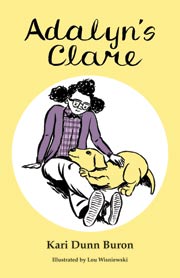 Adalyn is a bright student but has trouble fitting into her fourth grade class. Friendless and prone to tantrums, she frequently has to take refuge in a small tent in the school counselor’s office. One day, a yellow Labrador retriever puppy joins her in the tent, and quickly the two—Adalyn and the therapy-dog-in-training that she names Clare—become inseparable.
Adalyn is a bright student but has trouble fitting into her fourth grade class. Friendless and prone to tantrums, she frequently has to take refuge in a small tent in the school counselor’s office. One day, a yellow Labrador retriever puppy joins her in the tent, and quickly the two—Adalyn and the therapy-dog-in-training that she names Clare—become inseparable.
Adalyn’s Clare, written by Kari Dunn Burton with pen-and-ink illustrations by Lou Wisniewski and published in 2013 by AAPC (Autism Asperger’s Publishing Company), introduces middle grade readers to the role therapy dogs play in helping children on the autism spectrum. The omniscient narrative includes the thoughts of three-month-old Clare and the various animals in Mr. Spencer’s science class as well as conversation among the animals. While presenting animal characters with human traits in an otherwise realistic story is generally frowned upon, in this case it works well to present both the emotions of a child on the spectrum who also suffers from severe anxiety and her attachment to animals in lieu of her more confusing and sometimes cruel peers. In creating the relationships among Adalyn, Clare, and the other animals, Buron draws from the writings of scientist Temple Grandin, whose insights from having autism have led her to design more humane facilities for housing animals.
The story centers on Clare’s efforts to find a “pack” for Adalyn. Dogs are pack animals, and instinctively, Clare knows that a pack is necessary for survival and solitary creatures like Adalyn are quite vulnerable. As the science-class rat observes, “If I had traveled with a pack in the good old days, I might still be a free rat.”
Both Adalyn and Clare grow in competence and confidence in the course of the story, and Clare’s sense of responsibility for her charge will appeal to child readers on the spectrum whose empathy toward the struggling animal can help them to understand human animals better as well. Adalyn rings true as a character with Asperger’s syndrome, even though the condition is not specifically mentioned (possibly due to the reclassification of Asperger’s under the full autism spectrum in the upcoming DSM-V). Buron does an admirable job of creating secondary characters whose situations mirror that of Clare—for instance, a student teacher with whom Adalyn starts off on the wrong foot but who turns out to have a lot in common with the youngster. This well researched and thoughtfully written story will have special appeal to young readers on the autism spectrum or those who have social anxiety, as well as anyone interested in the work of therapy dogs. It is a must read for any adult who works with elementary-age children with special needs.
And as a treat, here’s my dog, Charlie, who would have made a great therapy dog for others except that he barks at big dogs and didn’t get accepted into the program.

1 comment for “Dogs at Work: A Review of Adalyn’s Clare”